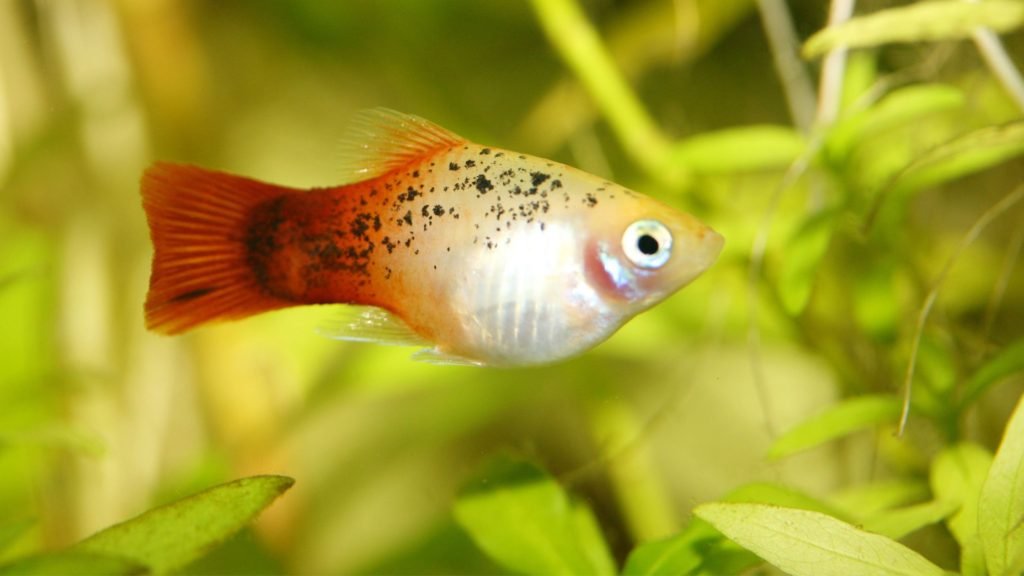Are you considering adding a colorful and fascinating fish to your aquarium? Look no further than the Mickey Mouse platy! These charming little fish are known for their unique markings and friendly nature, making them perfect for beginners and experienced aquarists. In this guide, we’ll delve into everything you need to know about Mickey Mouse platies, from their types and care requirements to their lifespan and ideal tank setup. Read on to learn more about these delightful fish and how to keep them happy and healthy in your aquarium.
What is a Mickey Mouse Platy?
An Overview of Mickey Mouse Platies
Mickey Mouse platies, scientifically known as Xiphophorus maculatus, are a wide variety of freshwater fish native to Central America. They belong to the Poeciliidae family, which also includes guppies and mollies. Mickey Mouse platies get their name from the unique markings on their tails, which resemble the iconic silhouette of Disney’s Mickey Mouse. These fish are known for their peaceful nature and adaptability, making them an excellent choice for a community aquarium.
Types of Mickey Mouse Platies
Several types of Mickey Mouse platies are available in the aquarium trade. They come in various colors, such as red, orange, yellow, and blue, and can have different patterns on their bodies. Some common types of Mickey Mouse platies include:
- Red Mickey Mouse Platy: This type has a vibrant red body with a distinctive Mickey Mouse marking on its tail.
- Blue Mickey Mouse Platy: This variety features a blue body with the same Mickey Mouse marking.
- Tuxedo Mickey Mouse Platy: These fish have a striking black and white pattern, resembling a formal tuxedo, with the Mickey Mouse marking on their tails.
Caring for Mickey Mouse Platies
Feeding Your Mickey Mouse Platy
Mickey Mouse platies are omnivorous fish, requiring a balanced diet of plant- and animal-based foods. A high-quality flake or pellet food formulated for tropical fish will provide the necessary nutrients for your platy. In addition to commercial foods, you can also offer live or frozen foods such as brine shrimp, daphnia, and bloodworms as treats. Feeding Mickey Mouse platies various foods ensures a balanced diet and good health.
The Ideal Tank Setup for Mickey Mouse Platies
Mickey Mouse platies thrive in well-maintained aquariums with stable water conditions. They prefer a temperature range of 72-78°F (22-26°C) and a pH level between 7.0 and 8.0. It’s crucial to regularly monitor and maintain water quality, as poor water conditions can lead to stress and disease in your fish.
A 10-gallon tank is the minimum recommended size for a small group of Mickey Mouse platies, with additional space required for each different fish. These fish enjoy having plenty of hiding spots, so include live plants, rocks, and other decorations to create a comfortable environment.
Keeping Mickey Mouse Platies in a Community Tank
Mickey Mouse platies are peaceful fish that can coexist with other non-aggressive fish species in a community tank. Some suitable tankmates for Mickey Mouse platies include:
- Tetras
- Guppies
- Mollies
- Corydoras Catfish
- Dwarf Gouramis
However, avoiding housing your platies with larger, more aggressive fish, such as cichlids, is essential, as they may become stressed or injured
Mickey Mouse Platy Lifespan
Mickey Mouse platies typically have a lifespan of 3 to 5 years when properly cared for in a well-maintained aquarium. Factors such as water quality, diet, and stress levels can impact the overall lifespan of your fish. To ensure your Mickey Mouse platies live a long and healthy life, providing them with a suitable environment, proper nutrition, and regular care is essential.
Breeding Mickey Mouse Platies
Mickey Mouse platies are livebearers, which means they give birth to live young instead of laying eggs. Breeding these fish can be relatively easy, making them popular for aquarists interested in producing their fish. To encourage successful breeding, consider the following tips:
- Provide a separate breeding tank: Setting up an independent tank for breeding will help reduce stress on the fish and increase the chances of successful reproduction. A 10-gallon tank with plenty of hiding spots for the fry (baby fish) will be sufficient.
- Maintain optimal water conditions: As with the main tank, ensure the breeding tank has stable water conditions, with a temperature between 72-78°F (22-26°C) and a pH level between 7.0 and 8.0.
- Introduce a male and female pair: Introduce a healthy male and female Mickey Mouse platy to the breeding tank, ensuring they are well-fed and stress-free. The female will typically develop a rounder belly when she is pregnant.
- Monitor for signs of pregnancy: Watch for signs of pregnancy in the female, such as a dark gravid spot near the anal fin. The gestation period for Mickey Mouse platies is approximately 28 days, after which the female will give birth to live fry.
- Remove adult fish after birth: Once the fry is born, remove the adult fish from the breeding tank to prevent them from eating the fry.
- Feed the fry: Feed the fry a balanced diet of finely crushed flakes and live or frozen foods such as baby brine shrimp. Frequent, small feedings will help the fry grow and develop properly.
Common Health Issues in Mickey Mouse Platy
Like any fish, Mickey Mouse platy can be susceptible to various health issues if not correctly cared for. Some common health problems include:
- Ich: Ich, also known as white spot disease, is a common parasitic infection that can affect Mickey Mouse platies. Symptoms include small white spots on the fish’s body and fins and rubbing against objects in the tank. To treat ich, raise the water temperature to 82°F (28°C) for ten days and add a recommended ich medication.
- Fin rot: Fin rot is a bacterial infection that can cause the fish’s fins to become frayed and discolored. This condition is often a result of poor water quality or stress. Improve water conditions and treat the tank with a suitable antibacterial medication to combat fin rot.
- Swim bladder disease: Swim bladder disease can cause your Mickey Mouse platy to have difficulty swimming or maintaining proper buoyancy. Several factors, including overfeeding, constipation, or infection, can cause this condition. To treat swim bladder disease, reduce feeding, and consider providing a high-fiber diet, such as cooked peas, to help alleviate constipation.
Where to Buy Mickey Mouse Platies
Most neighborhood pet stores and aquarium retailers that sell freshwater fish carry Mickey Mouse platies. When purchasing a Mickey Mouse platy, choosing a reputable store that maintains clean and healthy tanks is essential. Look for fish that are active, have vibrant colors, and show no signs of illness or stress. It’s also a good idea to ask the store staff about the fish’s origins and any specific care requirements that may differ from the general guidelines provided in this article.
Alternatively, you can purchase Mickey Mouse platies from reputable online retailers specializing in aquarium fish. When buying fish online, research the seller’s reputation and read customer reviews to ensure you receive healthy, high-quality fish.
Tips for Introducing Mickey Mouse Platies to Your Aquarium
Introducing new fish to your aquarium can be an exciting but potentially stressful experience for you and your existing fish. To ensure a smooth transition, follow these steps when adding Mickey Mouse platies to your tank:
- Acclimate the fish: When you bring your new Mickey Mouse platies home, it’s essential to acclimate them to the water conditions in your tank. Float the bag containing the fish in your aquarium for 15-20 minutes to allow the water temperature to equalize. Then, gradually add small amounts of your tank water to the bag over the next 15-20 minutes to help the fish adjust to the water chemistry.
- Release the fish: Gently release the Mickey Mouse platies into the tank, not introducing any water from the bag, as it may contain contaminants or pathogens.
- Monitor closely: Keep a close eye on your new fish and existing tank inhabitants to ensure they get along and show no signs of stress or aggression.
- Quarantine if necessary: If you notice any signs of illness or distress in your new fish, it’s essential to remove them from the main tank and place them in a separate quarantine tank for observation and treatment.
Conclusion
Mickey Mouse platies are an excellent addition to any freshwater aquarium, with their unique markings and friendly nature. By understanding the various types of Mickey Mouse platies and providing proper care, nutrition, and tank setup, you can ensure that your fish live long, healthy lives. Breeding these beautiful fish can also be a rewarding experience for aquarists of all skill levels. So, you’re looking for a colorful and fascinating fish to add to your aquatic community. Consider the Mickey Mouse platy. In that case, they will bring joy and excitement to your aquarium!

